tow FIAT 500C 2019 Owner's Guide
[x] Cancel search | Manufacturer: FIAT, Model Year: 2019, Model line: 500C, Model: FIAT 500C 2019Pages: 332, PDF Size: 3.17 MB
Page 244 of 332
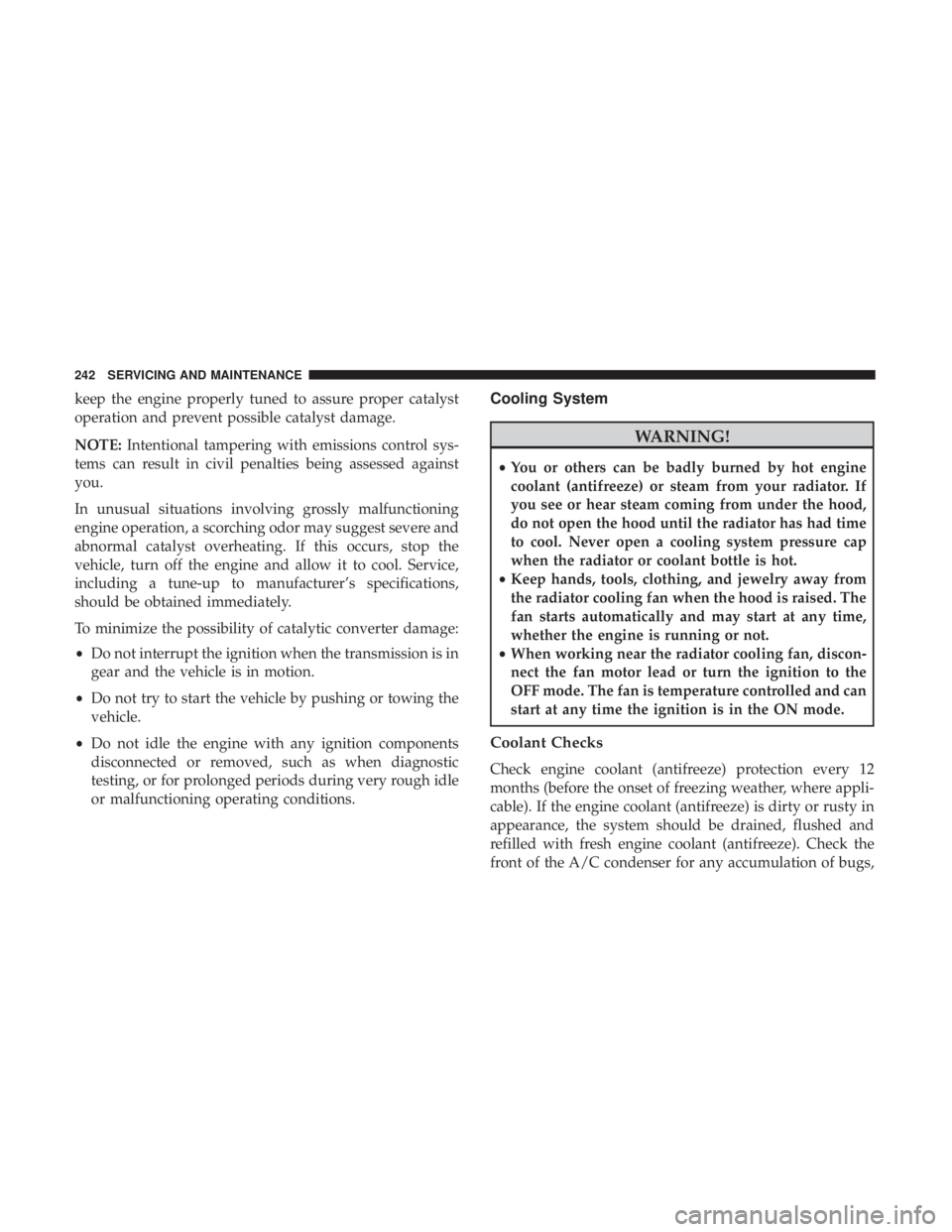
keep the engine properly tuned to assure proper catalyst
operation and prevent possible catalyst damage.
NOTE:Intentional tampering with emissions control sys-
tems can result in civil penalties being assessed against
you.
In unusual situations involving grossly malfunctioning
engine operation, a scorching odor may suggest severe and
abnormal catalyst overheating. If this occurs, stop the
vehicle, turn off the engine and allow it to cool. Service,
including a tune-up to manufacturer’s specifications,
should be obtained immediately.
To minimize the possibility of catalytic converter damage:
• Do not interrupt the ignition when the transmission is in
gear and the vehicle is in motion.
• Do not try to start the vehicle by pushing or towing the
vehicle.
• Do not idle the engine with any ignition components
disconnected or removed, such as when diagnostic
testing, or for prolonged periods during very rough idle
or malfunctioning operating conditions.Cooling System
WARNING!
• You or others can be badly burned by hot engine
coolant (antifreeze) or steam from your radiator. If
you see or hear steam coming from under the hood,
do not open the hood until the radiator has had time
to cool. Never open a cooling system pressure cap
when the radiator or coolant bottle is hot.
• Keep hands, tools, clothing, and jewelry away from
the radiator cooling fan when the hood is raised. The
fan starts automatically and may start at any time,
whether the engine is running or not.
• When working near the radiator cooling fan, discon-
nect the fan motor lead or turn the ignition to the
OFF mode. The fan is temperature controlled and can
start at any time the ignition is in the ON mode.
Coolant Checks
Check engine coolant (antifreeze) protection every 12
months (before the onset of freezing weather, where appli-
cable). If the engine coolant (antifreeze) is dirty or rusty in
appearance, the system should be drained, flushed and
refilled with fresh engine coolant (antifreeze). Check the
front of the A/C condenser for any accumulation of bugs,
242 SERVICING AND MAINTENANCE
Page 257 of 332
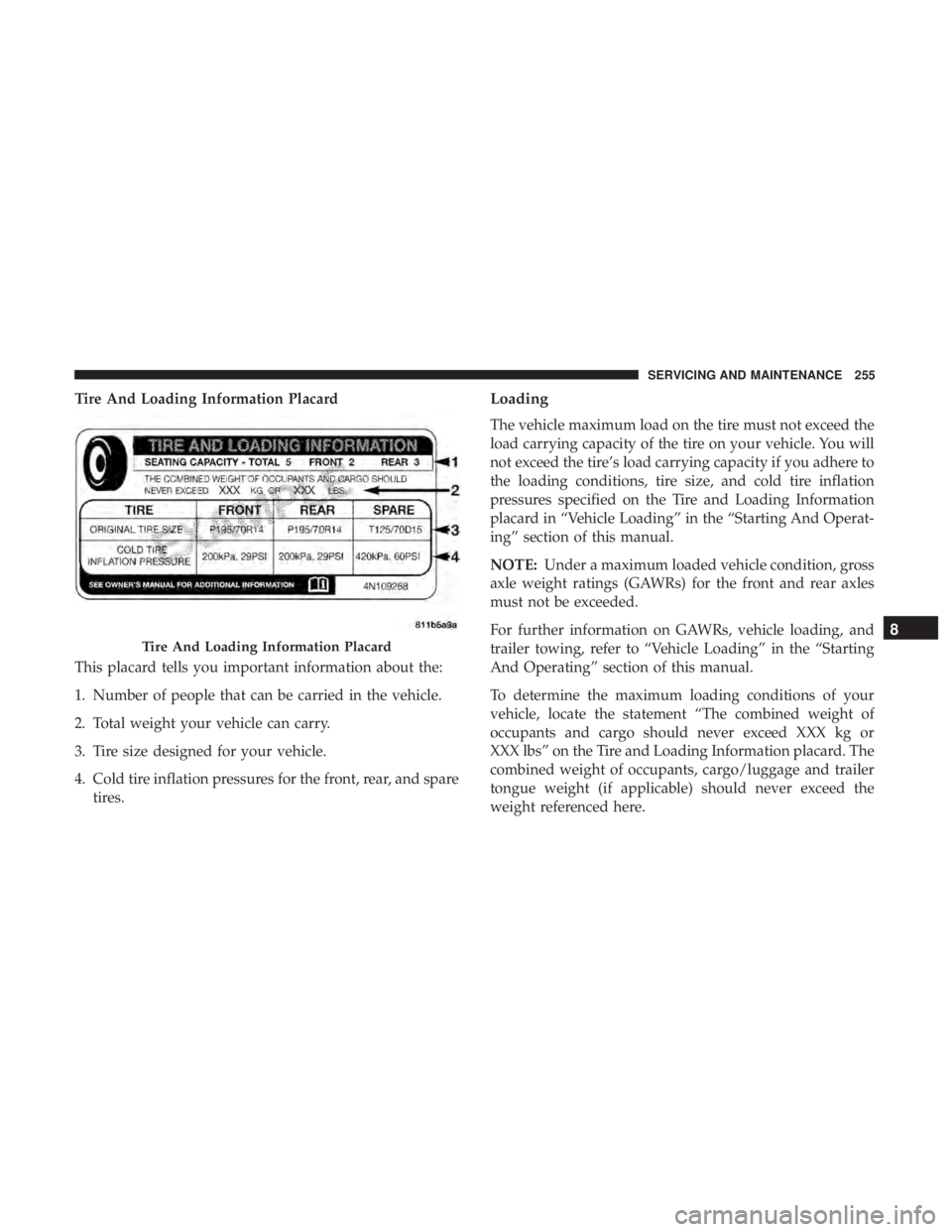
Tire And Loading Information Placard
This placard tells you important information about the:
1. Number of people that can be carried in the vehicle.
2. Total weight your vehicle can carry.
3. Tire size designed for your vehicle.
4. Cold tire inflation pressures for the front, rear, and sparetires.Loading
The vehicle maximum load on the tire must not exceed the
load carrying capacity of the tire on your vehicle. You will
not exceed the tire’s load carrying capacity if you adhere to
the loading conditions, tire size, and cold tire inflation
pressures specified on the Tire and Loading Information
placard in “Vehicle Loading” in the “Starting And Operat-
ing” section of this manual.
NOTE: Under a maximum loaded vehicle condition, gross
axle weight ratings (GAWRs) for the front and rear axles
must not be exceeded.
For further information on GAWRs, vehicle loading, and
trailer towing, refer to “Vehicle Loading” in the “Starting
And Operating” section of this manual.
To determine the maximum loading conditions of your
vehicle, locate the statement “The combined weight of
occupants and cargo should never exceed XXX kg or
XXX lbs” on the Tire and Loading Information placard. The
combined weight of occupants, cargo/luggage and trailer
tongue weight (if applicable) should never exceed the
weight referenced here.
Tire And Loading Information Placard
8
SERVICING AND MAINTENANCE 255
Page 258 of 332
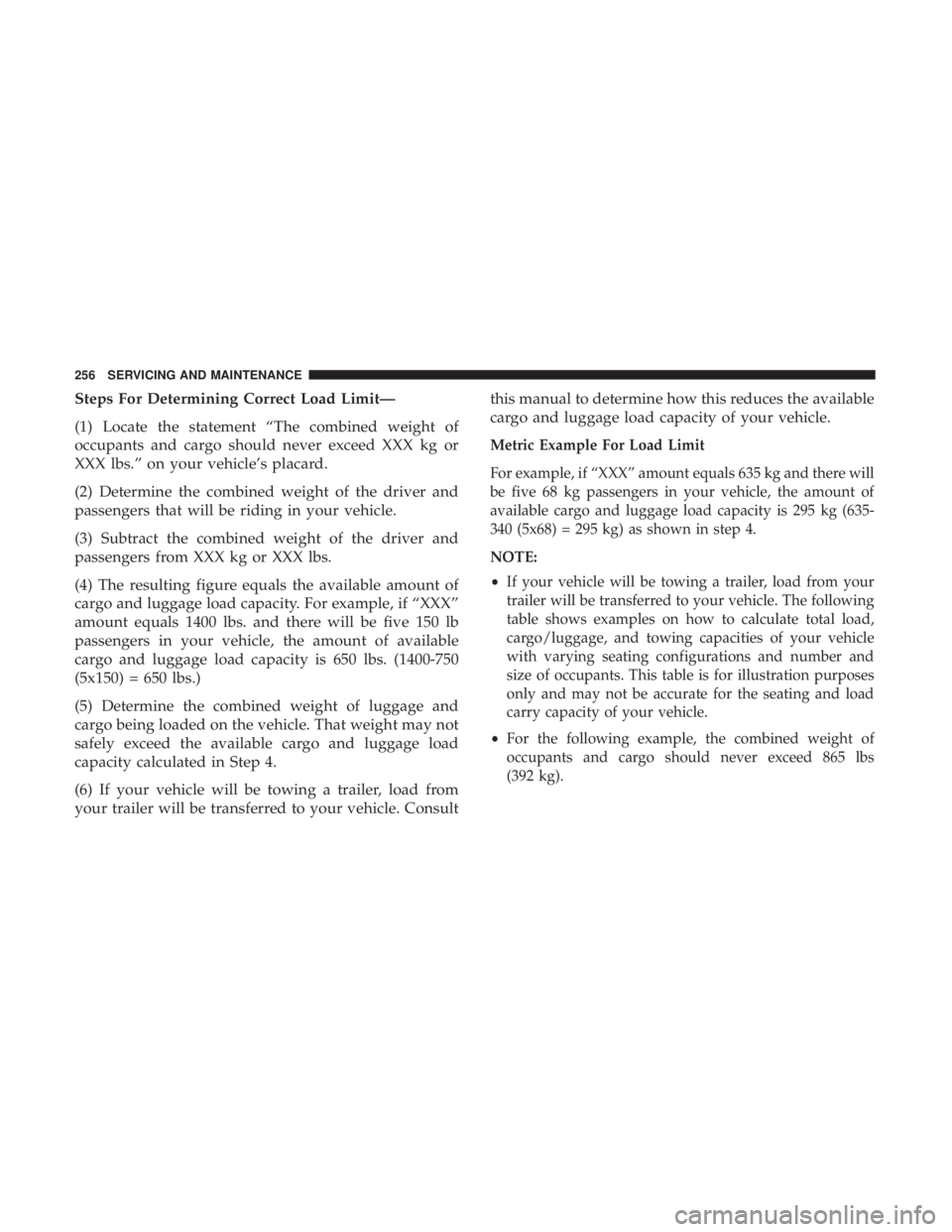
Steps For Determining Correct Load Limit—
(1) Locate the statement “The combined weight of
occupants and cargo should never exceed XXX kg or
XXX lbs.” on your vehicle’s placard.
(2) Determine the combined weight of the driver and
passengers that will be riding in your vehicle.
(3) Subtract the combined weight of the driver and
passengers from XXX kg or XXX lbs.
(4) The resulting figure equals the available amount of
cargo and luggage load capacity. For example, if “XXX”
amount equals 1400 lbs. and there will be five 150 lb
passengers in your vehicle, the amount of available
cargo and luggage load capacity is 650 lbs. (1400-750
(5x150) = 650 lbs.)
(5) Determine the combined weight of luggage and
cargo being loaded on the vehicle. That weight may not
safely exceed the available cargo and luggage load
capacity calculated in Step 4.
(6) If your vehicle will be towing a trailer, load from
your trailer will be transferred to your vehicle. Consultthis manual to determine how this reduces the available
cargo and luggage load capacity of your vehicle.
Metric Example For Load Limit
For example, if “XXX” amount equals 635 kg and there will
be five 68 kg passengers in your vehicle, the amount of
available cargo and luggage load capacity is 295 kg (635-
340 (5x68) = 295 kg) as shown in step 4.
NOTE:
•
If your vehicle will be towing a trailer, load from your
trailer will be transferred to your vehicle. The following
table shows examples on how to calculate total load,
cargo/luggage, and towing capacities of your vehicle
with varying seating configurations and number and
size of occupants. This table is for illustration purposes
only and may not be accurate for the seating and load
carry capacity of your vehicle.
• For the following example, the combined weight of
occupants and cargo should never exceed 865 lbs
(392 kg).
256 SERVICING AND MAINTENANCE
Page 263 of 332
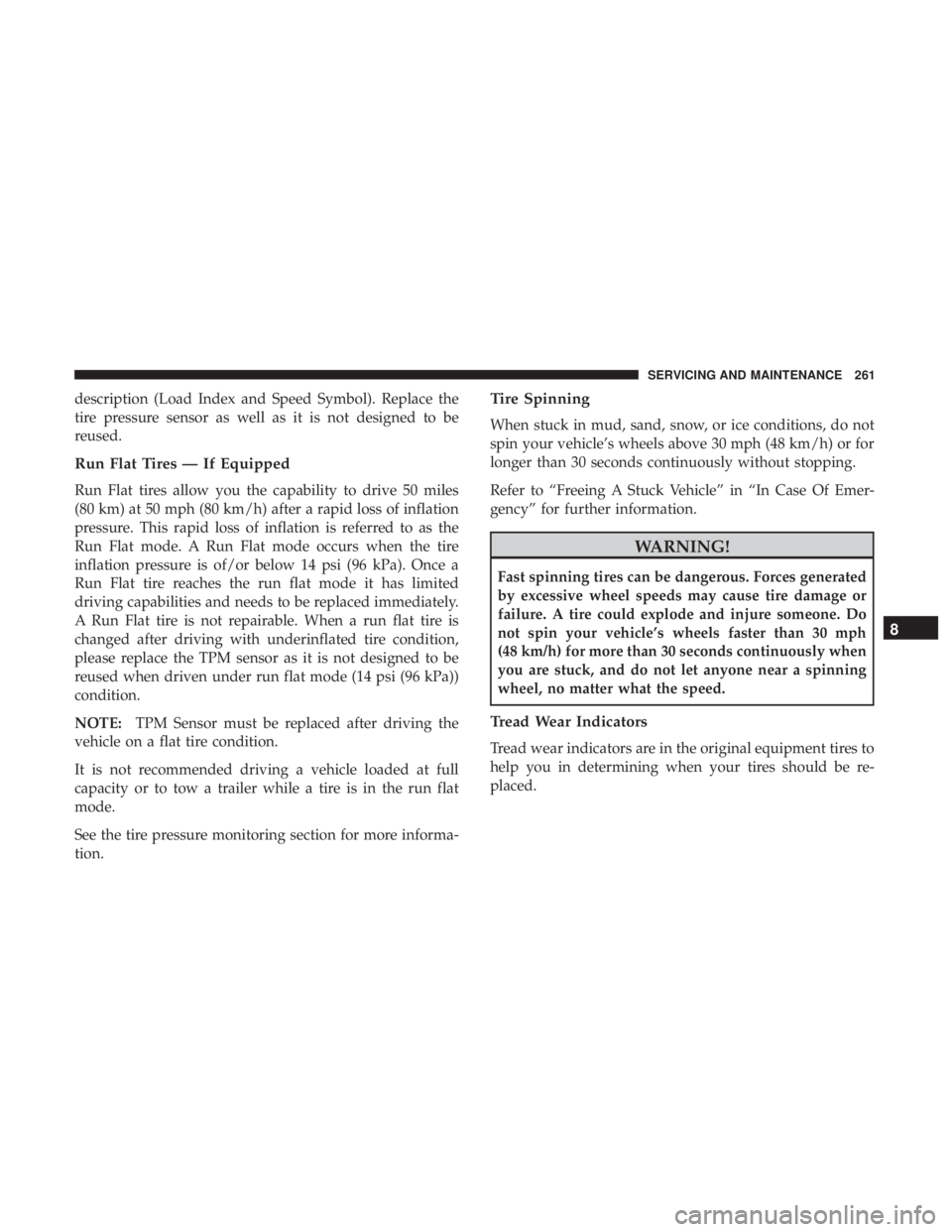
description (Load Index and Speed Symbol). Replace the
tire pressure sensor as well as it is not designed to be
reused.
Run Flat Tires — If Equipped
Run Flat tires allow you the capability to drive 50 miles
(80 km) at 50 mph (80 km/h) after a rapid loss of inflation
pressure. This rapid loss of inflation is referred to as the
Run Flat mode. A Run Flat mode occurs when the tire
inflation pressure is of/or below 14 psi (96 kPa). Once a
Run Flat tire reaches the run flat mode it has limited
driving capabilities and needs to be replaced immediately.
A Run Flat tire is not repairable. When a run flat tire is
changed after driving with underinflated tire condition,
please replace the TPM sensor as it is not designed to be
reused when driven under run flat mode (14 psi (96 kPa))
condition.
NOTE:TPM Sensor must be replaced after driving the
vehicle on a flat tire condition.
It is not recommended driving a vehicle loaded at full
capacity or to tow a trailer while a tire is in the run flat
mode.
See the tire pressure monitoring section for more informa-
tion.
Tire Spinning
When stuck in mud, sand, snow, or ice conditions, do not
spin your vehicle’s wheels above 30 mph (48 km/h) or for
longer than 30 seconds continuously without stopping.
Refer to “Freeing A Stuck Vehicle” in “In Case Of Emer-
gency” for further information.
WARNING!
Fast spinning tires can be dangerous. Forces generated
by excessive wheel speeds may cause tire damage or
failure. A tire could explode and injure someone. Do
not spin your vehicle’s wheels faster than 30 mph
(48 km/h) for more than 30 seconds continuously when
you are stuck, and do not let anyone near a spinning
wheel, no matter what the speed.
Tread Wear Indicators
Tread wear indicators are in the original equipment tires to
help you in determining when your tires should be re-
placed.
8
SERVICING AND MAINTENANCE 261
Page 267 of 332
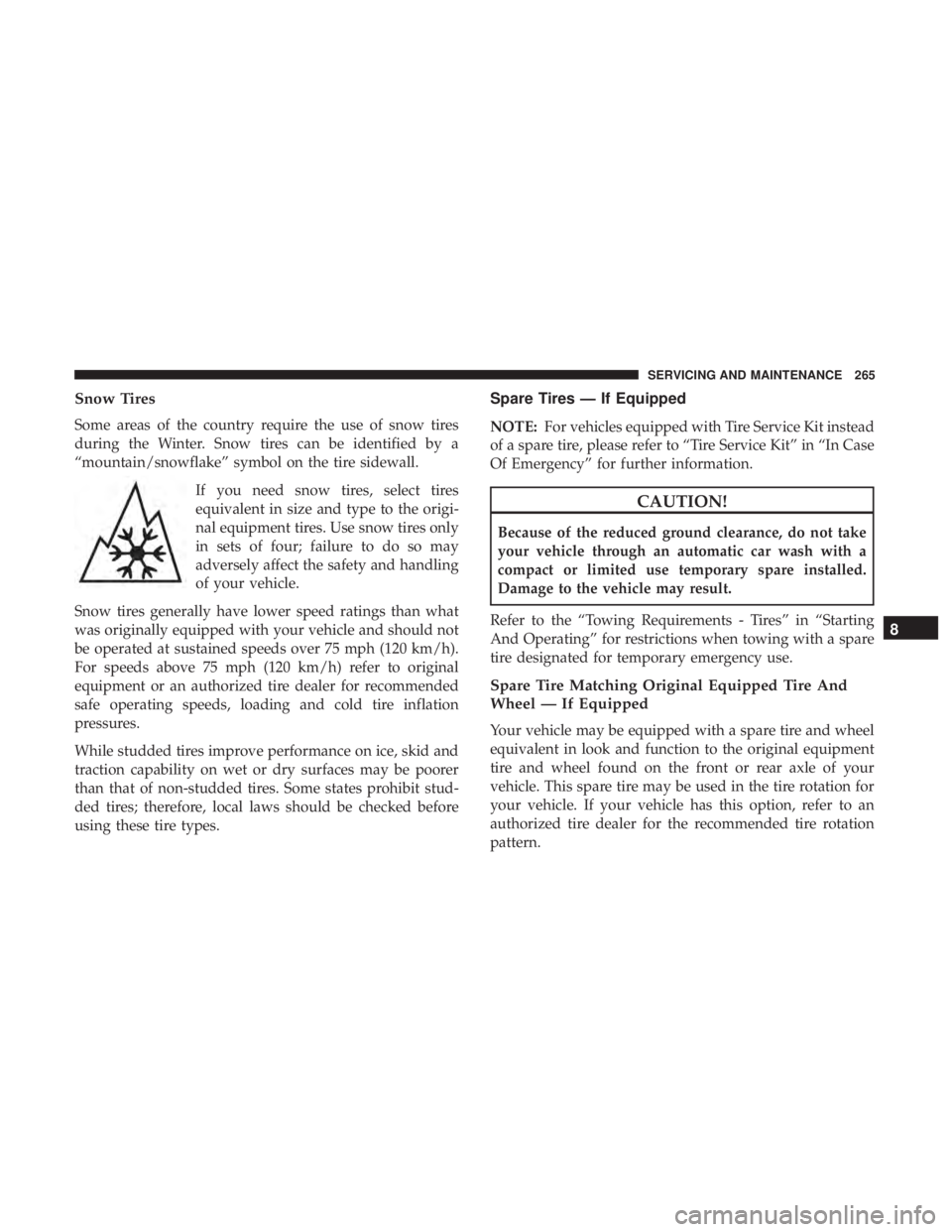
Snow Tires
Some areas of the country require the use of snow tires
during the Winter. Snow tires can be identified by a
“mountain/snowflake” symbol on the tire sidewall.If you need snow tires, select tires
equivalent in size and type to the origi-
nal equipment tires. Use snow tires only
in sets of four; failure to do so may
adversely affect the safety and handling
of your vehicle.
Snow tires generally have lower speed ratings than what
was originally equipped with your vehicle and should not
be operated at sustained speeds over 75 mph (120 km/h).
For speeds above 75 mph (120 km/h) refer to original
equipment or an authorized tire dealer for recommended
safe operating speeds, loading and cold tire inflation
pressures.
While studded tires improve performance on ice, skid and
traction capability on wet or dry surfaces may be poorer
than that of non-studded tires. Some states prohibit stud-
ded tires; therefore, local laws should be checked before
using these tire types.
Spare Tires — If Equipped
NOTE: For vehicles equipped with Tire Service Kit instead
of a spare tire, please refer to “Tire Service Kit” in “In Case
Of Emergency” for further information.
CAUTION!
Because of the reduced ground clearance, do not take
your vehicle through an automatic car wash with a
compact or limited use temporary spare installed.
Damage to the vehicle may result.
Refer to the “Towing Requirements - Tires” in “Starting
And Operating” for restrictions when towing with a spare
tire designated for temporary emergency use.
Spare Tire Matching Original Equipped Tire And
Wheel — If Equipped
Your vehicle may be equipped with a spare tire and wheel
equivalent in look and function to the original equipment
tire and wheel found on the front or rear axle of your
vehicle. This spare tire may be used in the tire rotation for
your vehicle. If your vehicle has this option, refer to an
authorized tire dealer for the recommended tire rotation
pattern.
8
SERVICING AND MAINTENANCE 265
Page 280 of 332
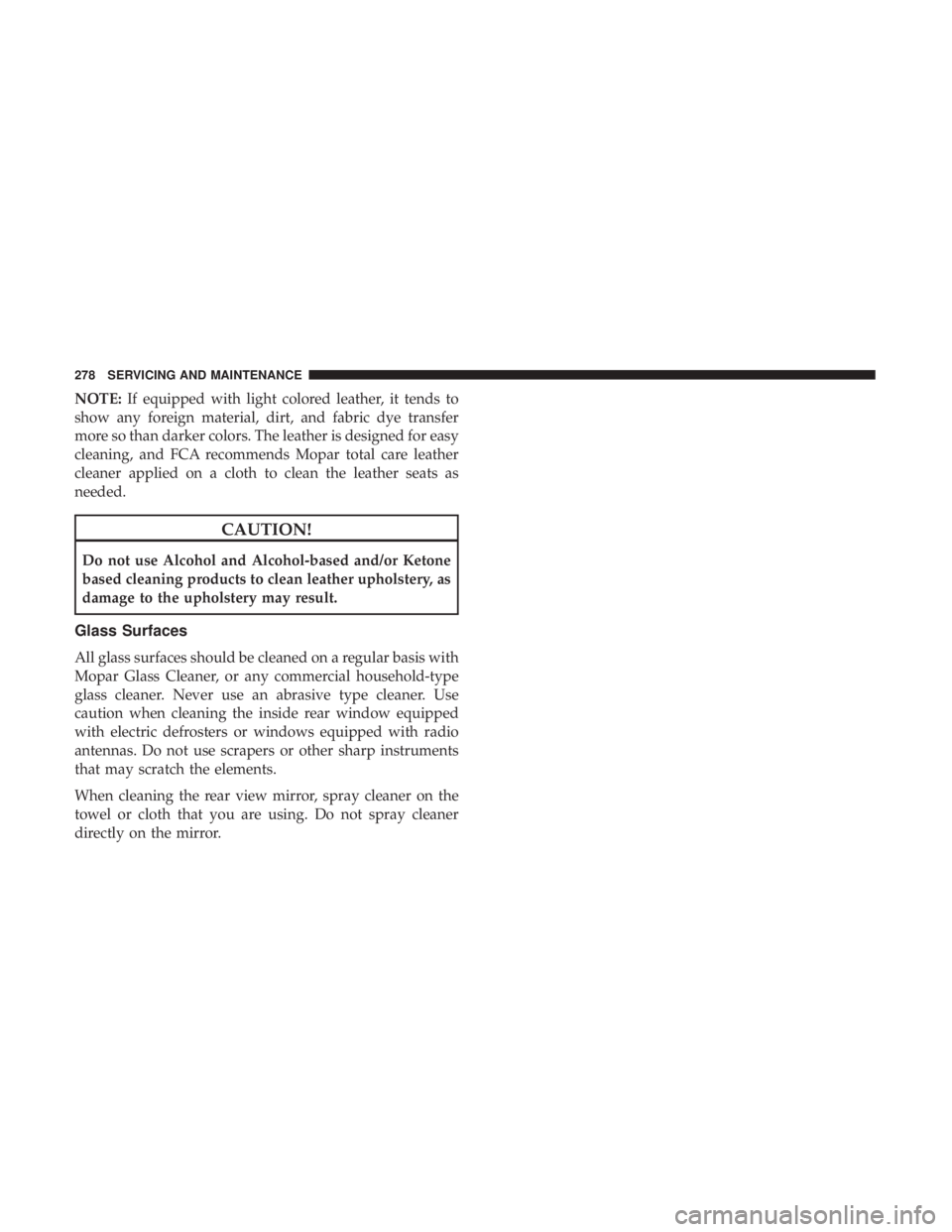
NOTE:If equipped with light colored leather, it tends to
show any foreign material, dirt, and fabric dye transfer
more so than darker colors. The leather is designed for easy
cleaning, and FCA recommends Mopar total care leather
cleaner applied on a cloth to clean the leather seats as
needed.
CAUTION!
Do not use Alcohol and Alcohol-based and/or Ketone
based cleaning products to clean leather upholstery, as
damage to the upholstery may result.
Glass Surfaces
All glass surfaces should be cleaned on a regular basis with
Mopar Glass Cleaner, or any commercial household-type
glass cleaner. Never use an abrasive type cleaner. Use
caution when cleaning the inside rear window equipped
with electric defrosters or windows equipped with radio
antennas. Do not use scrapers or other sharp instruments
that may scratch the elements.
When cleaning the rear view mirror, spray cleaner on the
towel or cloth that you are using. Do not spray cleaner
directly on the mirror.
278 SERVICING AND MAINTENANCE
Page 319 of 332
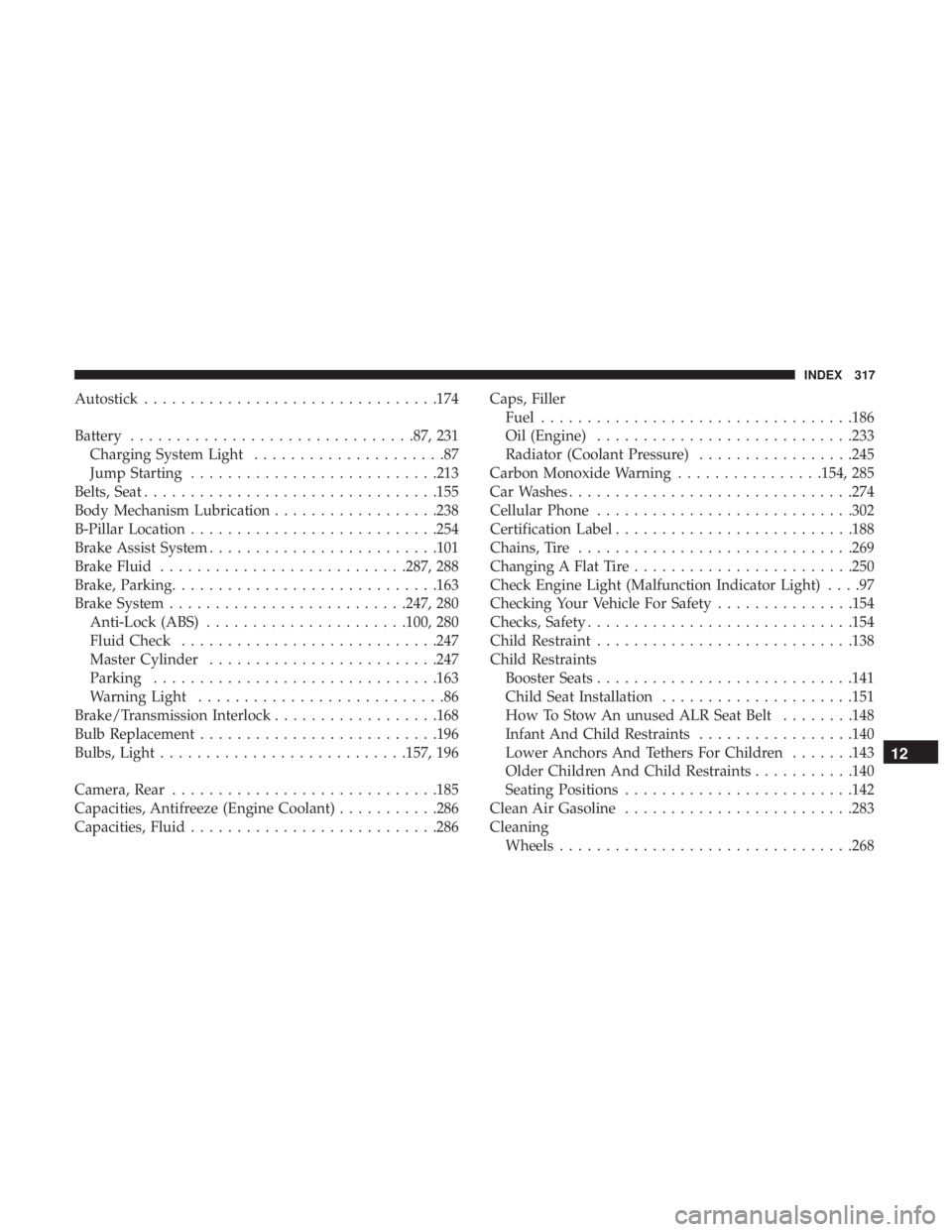
Autostick............................... .174
Battery .............................. .87, 231
Charging System Light .....................87
Jump Starting .......................... .213
Belts, Seat ............................... .155
Body Mechanism Lubrication ..................238
B-Pillar Location .......................... .254
Brake Assist System ........................ .101
Brake Fluid .......................... .287, 288
Brake, Parking ............................ .163
Brake System ......................... .247, 280
Anti-Lock (ABS) ..................... .100, 280
Fluid Check ........................... .247
Master Cylinder ........................ .247
Parking .............................. .163
Warning Light ...........................86
Brake/Transmission Interlock ..................168
Bulb Replacement ......................... .196
Bulbs, Light .......................... .157, 196
Camera, Rear ............................ .185
Capacities, Antifreeze (Engine Coolant) ...........286
Capacities, Fluid .......................... .286Caps, Filler
Fuel ................................. .186
Oil (Engine) ........................... .233
Radiator (Coolant Pressure) .................245
Carbon Monoxide Warning ................154, 285
Car Washes .............................. .274
Cellular Phone ........................... .302
Certification Label ......................... .188
Chains, Tire ............................. .269
Changing A Flat Tire ....................... .250
Check Engine Light (Malfunction Indicator Light) ....97
Checking Your Vehicle For Safety ...............154
Checks, Safety ............................ .154
Child Restraint ........................... .138
Child
Restraints
Booster Seats ........................... .141
Child Seat Installation .....................151
How To Stow An unused ALR Seat Belt ........148
Infant And Child Restraints .................140
Lower Anchors And Tethers For Children .......143
Older Children And Child Restraints ...........140
Seating Positions ........................ .142
Clean Air Gasoline ........................ .283
Cleaning Wheels ............................... .268
12
INDEX 317
Page 321 of 332
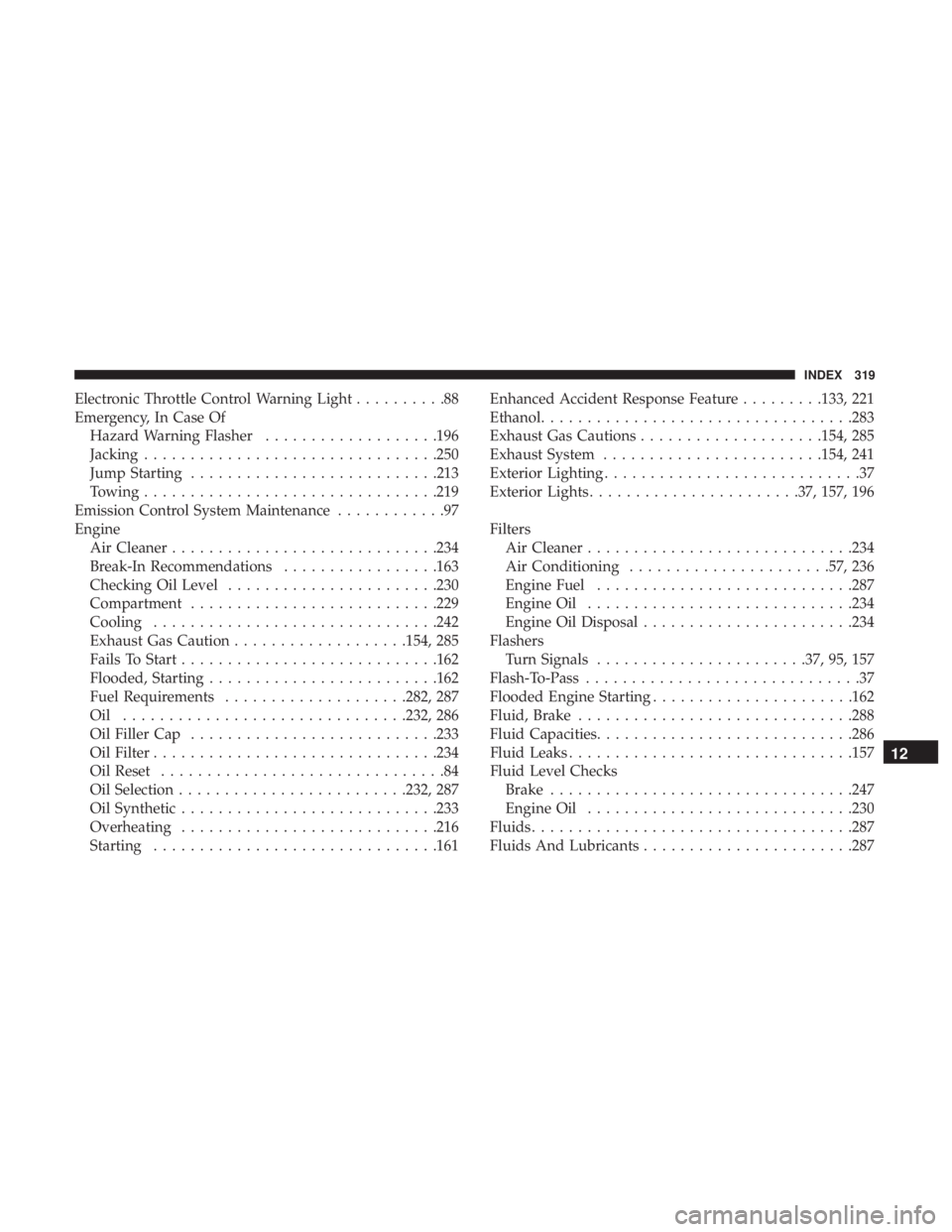
Electronic Throttle Control Warning Light..........88
Emergency, In Case Of Hazard Warning Flasher ...................196
Jacking ............................... .250
Jump Starting .......................... .213
Towing ............................... .219
Emission Control System Maintenance ............97
Engine Air Cleaner ............................ .234
Break-In Recommendations .................163
Checking Oil Level ...................... .230
Compartment .......................... .229
Cooling .............................. .242
Exhaust Gas Caution ...................154, 285
Fails To Start ........................... .162
Flooded, Starting ........................ .162
Fuel Requirements ....................282, 287
Oil .............................. .232, 286
Oil Filler Cap .......................... .233
Oil Filter .............................. .234
Oil Reset ...............................84
Oil Selection ........................ .232, 287
Oil Synthetic ........................... .233
Overheating ........................... .216
Starting .............................. .161Enhanced Accident Response Feature
.........133, 221
Ethanol ................................. .283
Exhaust Gas Cautions ....................154, 285
Exhaust System ....................... .154, 241
Exterior Lighting ............................37
Exterior Lights ...................... .37, 157, 196
Filters Air Cleaner ............................ .234
Air Conditioning ..................... .57, 236
Engine Fuel ........................... .287
Engine Oil ............................ .234
Engine Oil Disposal ...................... .234
Flashers Turn Signals ...................... .37,
95, 157
Flash-To-Pass ..............................37
Flooded Engine Starting ..................... .162
Fluid, Brake ............................. .288
Fluid Capacities ........................... .286
Fluid Leaks .............................. .157
Fluid Level Checks Brake ................................ .247
Engine Oil ............................ .230
Fluids .................................. .287
Fluids And Lubricants ...................... .287
12
INDEX 319
Page 325 of 332
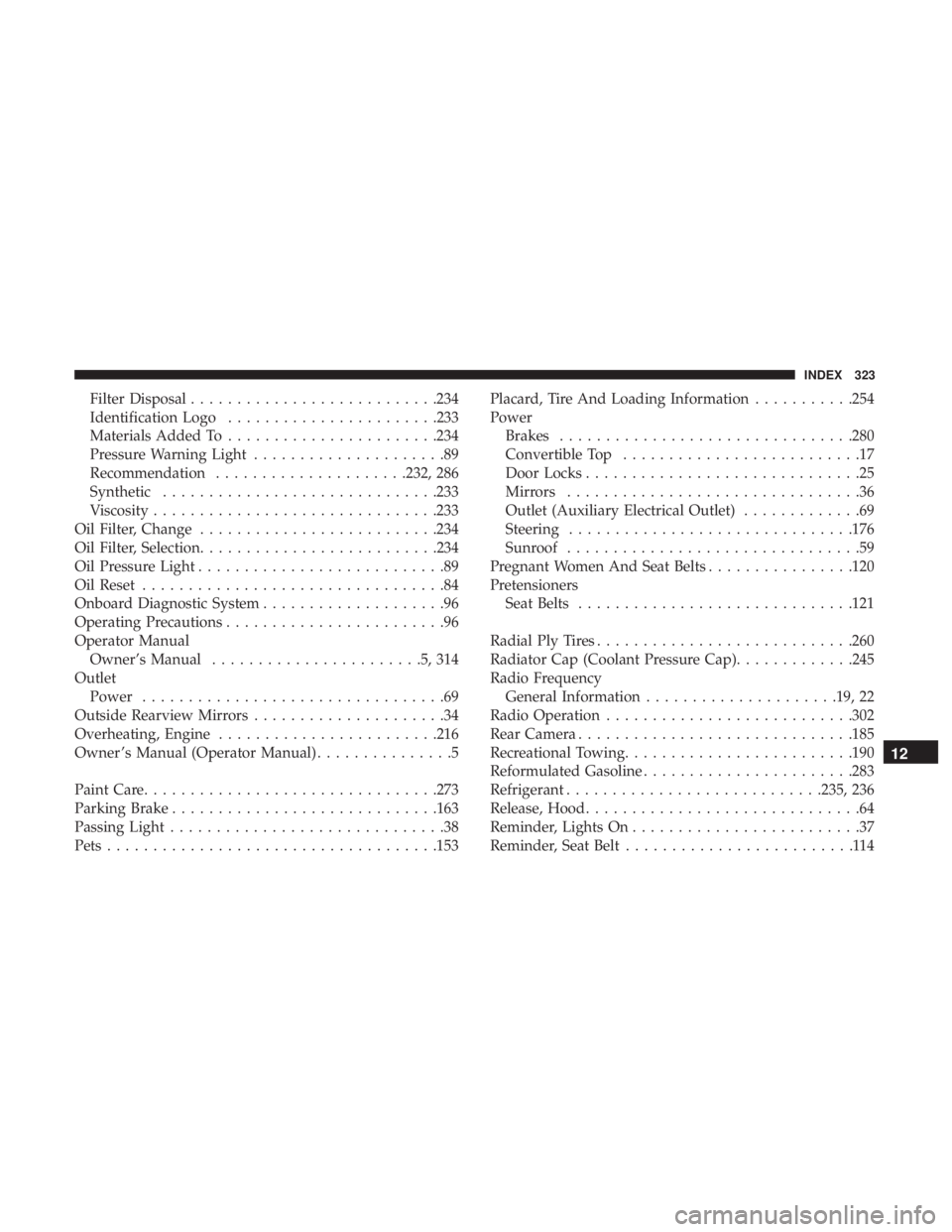
Filter Disposal.......................... .234
Identification Logo ...................... .233
Materials Added To ...................... .234
Pressure Warning Light .....................89
Recommendation .....................232, 286
Synthetic ............................. .233
Viscosity .............................. .233
Oil Filter, Change ......................... .234
Oil Filter, Selection ......................... .234
Oil Pressure Light ...........................89
Oil Reset .................................84
Onboard Diagnostic System ....................96
Operating Precautions ........................96
Operator Manual Owner’s Manual .......................5,314
Outlet Power .................................69
Outside Rearview Mirrors .....................34
Overheating, Engine ....................... .216
Owner ’s Manual (Operator Manual) ...............5
Paint Care ............................... .273
Parking Brake ............................ .163
Passing Light ..............................38
Pets ................................... .153Placard, Tire And Loading Information
...........254
Power Brakes ............................... .280
Convertible Top ..........................17
Door Locks ..............................25
Mirrors ................................36
Outlet (Auxiliary Electrical Outlet) .............69
Steering .............................. .176
Sunroof ................................59
Pregnant Women And Seat Belts ................120
Pretensioners Seat Belts ............................. .121
Radial Ply Tires ........................... .260
Radiator Cap (Coolant Pressure Cap) .............245
Radio Frequency General Information .....................19, 22
Radio Operation .......................... .302
Rear Camera ............................. .185
Recreational Towing ........................ .190
Reformulated
Gasoline...................... .283
Refrigerant ........................... .235, 236
Release, Hood ..............................64
Reminder, Lights On .........................37
Reminder, Seat Belt .........................11412
INDEX 323
Page 328 of 332
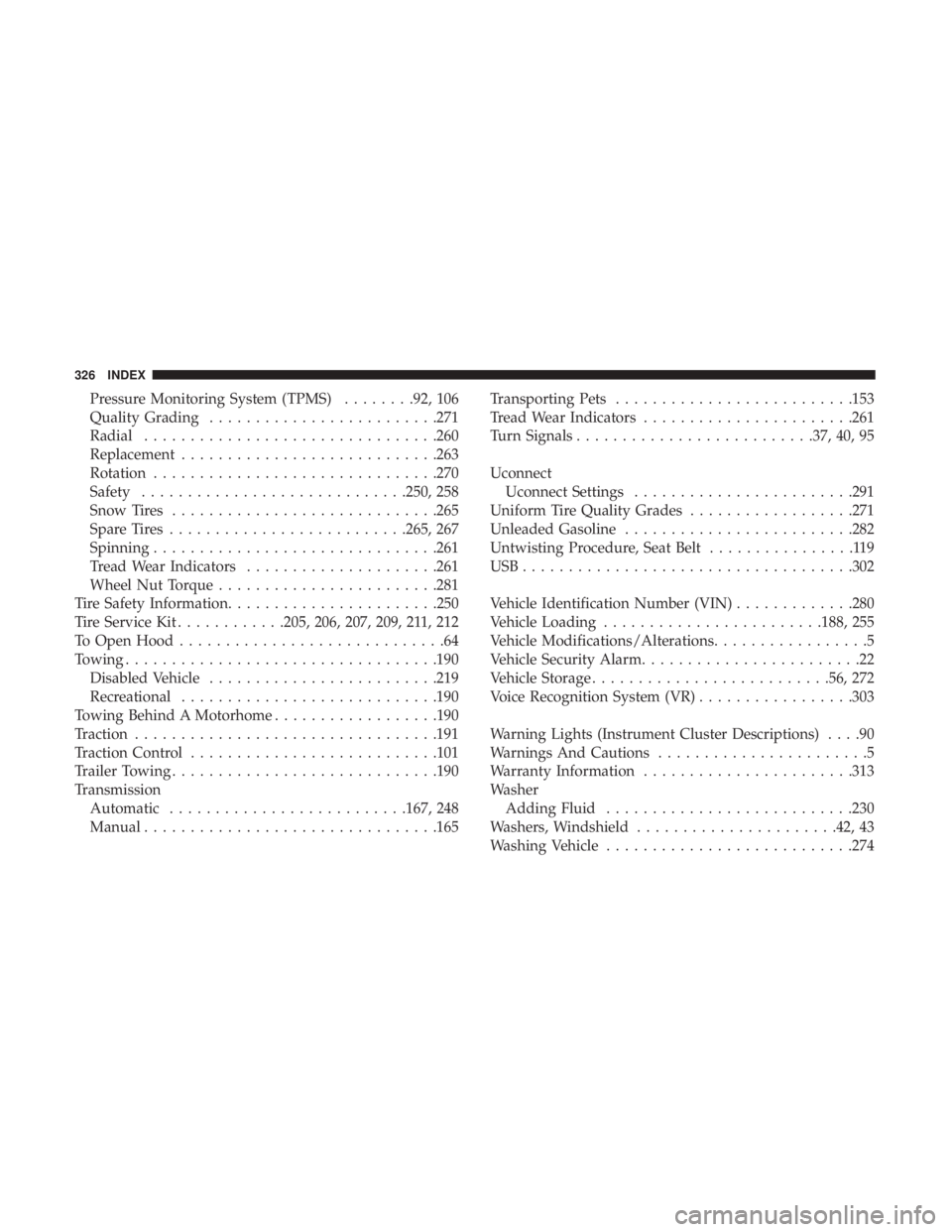
Pressure Monitoring System (TPMS)........92, 106
Quality Grading ........................ .271
Radial ............................... .260
Replacement ........................... .263
Rotation .............................. .270
Safety ............................ .250, 258
Snow Tires ............................ .265
Spare Tires ......................... .265, 267
Spinning .............................. .261
Tread Wear Indicators .....................261
Wheel Nut Torque ....................... .281
Tire Safety Information ...................... .250
Tire Service Kit ............205, 206, 207, 209, 211, 212
To Open Hood .............................64
Towing ................................. .190
Disabled Vehicle ........................ .219
Recreational ........................... .190
Towing Behind A Motorhome ..................190
Traction ................................ .191
Traction Control .......................... .101
Trailer Towing ............................ .190
Transmission Automatic ......................... .167, 248
Manual ............................... .165Transporting Pets
......................... .153
Tread Wear Indicators ...................... .261
Turn Signals ......................... .37, 40, 95
Uconnect Uconnect Settings ....................... .291
Uniform Tire Quality Grades ..................271
Unleaded Gasoline ........................ .282
Untwisting Procedure, Seat Belt ................119
USB................................... .302
Vehicle Identification Number (VIN) .............280
Vehicle Loading ....................... .188, 255
Vehicle Modifications/Alterations .................5
Vehicle Security Alarm ........................22
V
ehicle Storage ......................... .56, 272
Voice Recognition System (VR) .................303
Warning Lights (Instrument Cluster Descriptions) ....90
Warnings And Cautions .......................5
Warranty Information ...................... .313
Washer Adding Fluid .......................... .230
Washers, Windshield ..................... .42, 43
Washing Vehicle .......................... .274
326 INDEX